Spotted RedshankCommon RedshankMarsh SandpiperGreenshank Green Sandpiper Wood Sandpiper Terek Sandpiper Common Sandpiper
Spotted Redshank🠉
Tringa erythropus
Could be confused with the Common Redshank, but in comparison with it, the Spotted Redshank is more slender with slightly longer legs, and a longer, finer bill with the tip slightly downcurved, black in colour apart from a red base to the lower mandible. In juveniles and non-breeding adults, there is a clearly more obvious white supercilium. The flight is stronger and faster. The wings are uniform (dark). It shows an oval white patch on the back, and the toes extend noticeably beyond the tail.
Unlike the Common Redshank, this wader is often seen in deeper water, and it swims readily.
In breeding plumage, the adult is very dark (black), whereas in non-breeding plumage, it is grey above and unmarked white below. Juveniles have the underparts evenly barred, and have a more scaly pattern on the upperparts than non-breeding adults.
Call: distinctive sharp, disyllabic “ki-wit” or tchu-itt”.
L. 29-33 cm ; W. 48-52 cm.
Similar species: Common Redshank, Greenshank, Marsh Sandpiper.
©Thomas Blanchon
Common Redshank🠉
Tringa totanus
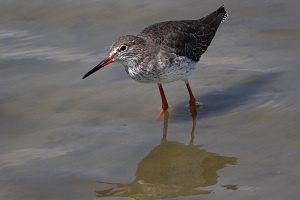
The legs and the base of the bill are red.
In all plumages, it is brownish above, the chest is streaked, and the flanks are spotted. It shows a narrow, short pale supercilium in front of the eye, and a whitish eye-ring. The bill is straight, fairly thick and medium length, red and black.
It appears quite stocky in flight, and a broad white border to the trailing edge of the wing can be seen, creating a white wingbar, as well as a white patch on the rump running up into a point on the back.
In breeding plumage, the adult shows coarse, irregular marks above and below, while the non-breeding adult is uniformly brownish-grey above and on the chest, with sparse barring or streaking on the flanks and undertail. Juveniles are distinctly streaked below, spotted above, and the legs are yellow-orange.
Call: loud whistled single “tcheut” or disyllabic “tcheu-hu”.
L. 24-27 cm ; W. 47-53 cm.
Similar species: Spotted Redshank, Greenshank, Marsh Sandpiper.
©Thomas Galewski
Marsh Sandpiper🠉
Tringa stagnatilis
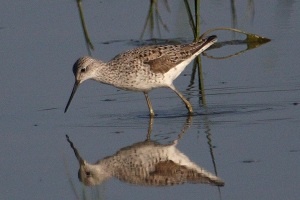
Noticeably smaller in size than the Greenshank, intermediate between the Wood Sandpiper and Common Redshank. The Marsh Sandpiper is distinguished by a long, straight, very thin black bill, and very long legs, producing a slim, delicate appearance strongly recalling the Black-winged Stilt. The overall colouration is similar to the Greenshank, and it shows the same contrast in flight, with a white patch on the back, though narrower. In flight, the toes extend well beyond the tail. The legs are yellow or greenish-grey.
The most commonly heard call is a single “tiou”, similar to the Greenshank, but softer.
L. 22-25 cm ; W. 39-44 cm.
Similar species: Greenshank, Common Redshank, Spotted Redshank.
©Thomas Galewski
Greenshank🠉
Tringa nebularia

The same size as the Spotted Redshank, the Greenshank has a long, stout bill (blackish-green) more or less upcurved towards the tip. At a distance, the adult in non-breeding plumage and juveniles look grey above, with whitish head and neck. The legs are green to greenish-grey. The flight is strong and fast. The wings are long, and it shows a long, broad, pointed white patch on the back and rump, as well as a very white tail, which contrast with the dark wings.
The loud “tiou-tiou-tiou” call is easy to recognise.
L. 30-34 cm ; W. 55-62 cm.
Similar species: Common Redshank, Spotted Redshank, Marsh Sandpiper.
©Thomas Galewski
Green Sandpiper 🠉
Tringa ochropus
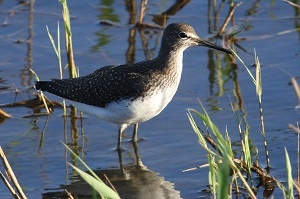
Of similar size to the Wood Sandpiper, the Green Sandpiper is, however, a little more heavily-built, and shorter-legged. The legs are greenish-grey coloured. The overall colouration is more contrasted than in the Wood Sandpiper, dark above (more or less speckled with pale), the neck and chest streaked and clearly cut off from the rest of the underparts, which are white. The white supercilium does not extend behind the eye. In flight, the toes barely extend beyond the tail, which is white with broad dark bars. The underwing is almost black.
Call: loud “huit-huit-huit”.
L. 20-24 cm ; W. 39-44 cm.
Similar species: Wood Sandpiper, Common Sandpiper.
©Thomas Galewski
Wood Sandpiper🠉
Tringa glareola
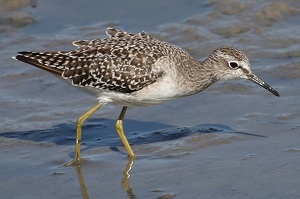
Small sandpiper, from 18.5 to 21 cm, which is often found in flocks on freshwater marshes. The legs are yellowish. The head shows an obvious supercilium. The adult is greyish with buffish and white spots above, while the juvenile is brown, and shows pale spots. The streaks on the upper chest are blurred in juveniles. In flight, the underwing is fairly pale greyish, the white tail has narrow dark bars, and the toes extend well beyond the tail.
The flight call is a rapid whistling.
L. 18.5-21 cm ; W. 35-39 cm.
Similar species: Green Sandpiper, Common Sandpiper.
©Thomas Galewski
Terek Sandpiper 🠉
Tringa cinerea
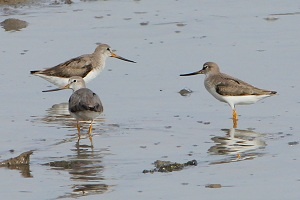
This wader has a similar shape to the Common Sandpiper, but differs in its steep forehead and very long upturned bill. It sometimes wags the rear of the body. The bill is black with a yellow or orangeish base. The short legs are dirty yellow to (more usually) orangeish. The upperparts (including the tail) are pale grey, and the wings show a white trailing edge a little like the Common Redshank.
The call is a series of 2 to 5 loud whistles “vivivivi”.
L. 22-25 cm ; W. 36-45 cm.
©Thomas Galewski
Common Sandpiper🠉
Actitis hypoleucos
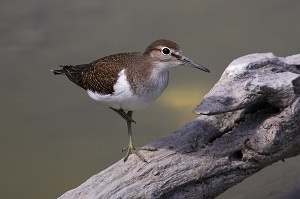
Small sandpiper (similar size or smaller than Wood Sandpiper), frequently wagging the rear of the body, and holding itself slightly crouching or leaning forward at the front. The distinctive flight is low over the surface of the water, with bursts of jerky wingbeats interspersed with brief pauses during which the wings are held curved downwards. The legs are dull yellow to brownish-grey with a green tinge. The upperparts are brown, as are the sides of the chest, which contrast markedly with the white underparts. The wing shows a conspicuous white bar.
The call is a rapid whistle, a loud “hii-dii-dii-dii-dii”.
L. 18-20.5 cm ; W. 32-35 cm.
Similar species: Wood Sandpiper, Green Sandpiper.
©Thomas Galewski




.png)
